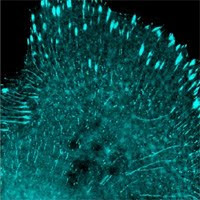A paper published by PLoS One on 08-15-09 demonstrated one RNA binding factor can bind to two completely different target RNA sequences while play leading roles in general splicing machinery and backup roles in alternative pre-mRNA splicing.
In Drosophila, sans-fille (snf) encodes a ~25-kDa protein that was found to carry the functions of two human proteins U1A and U2B”, components of general splicing machinery U1 and U2 snRNPs (small nuclear ribonucleoproteins), respectively. The SNF protein is able to do the double duties by binding to U1 RNA, the RNA component of the U1snRNP complex alone, and the U2 RNA of U2 snRNP if helped by another U2 snRNP -specific protein.
Busy as it sounds, snf has also been known for a long time to be a major participant of the fly sex determination pathway. When the master sex determination gene Sex-lethal (Sxl) is weakened by mutation or in the germ line before SXL fully takes over sex-specific development, snf is required to maintain appropriate splicing patterns of sex-specific transcripts such as Sxl.
How does a general splicing machinery component work specifically in regulated tissue-specific alternative splicing events?
The PLoSOne paper by researchers from Allele Biotech in San Diego and Peking University in China showed that the SNF protein can directly bind to elements of the Sxl pre-mRNA, in a way different from its binging to U1 RNA. Like many RRM (RNA Recognition Motif)- or RBD (RNA Binding Domain)-containing RNA binding proteins, SNF has more than one such conserved RNA binding motifs. Hu et al. in Bin Xia’s lab showed that SNF uses just one RRM to bind to U1 snRNA, but both RRMs to bind to consecutive U-bases on the Sxl pre-mRNA. The result was obtained through NMR analysis of SNF bound to RNAs. This structure-based conclusion agrees well with molecular biology results that showed a longer than usual RNA segment, e.g. ~16 U-bases, is needed for SNF to bind by Jiwu Wang, a co-senior author of the publication.
The long U-runs can be separated into two 8 U-base segments, each perhaps recognized by one RRM. More interestingly, from a mechanical point of view, the two segments can be separated by at least 120-nucleotide distance and still function as effective SNF binding substrate. Functionally, given that many ~8 U-runs surround the alternative splice site on the Sxl pre-mRNA, which are shown by Jiwu Wang’s earlier publications, to be cooperative binding site for the master sex determination factor SXL, it is intriguing to model that SNF binds to these same RNA elements for the same functions. But instead of binding to 2 U-runs cooperatively (therefore much more strongly) as SXL does, it needs 2 runs to just bind to the alternative splice sites. But when SNF does bind, the two U-runs may be used to loop out an entire region of RNA (such as an exon) by one SNF protein, providing effective regulatory functions. This could give a nearly perfect explanation as how SNF can help sex determination only when needed.
For more similar news: http://www.allelebiotech.com/News, or blogs http://allelebiotech.com/blogs/
Hu et al.
http://www.plosone.org/article/info%3Adoi%2F10.1371%2Fjournal.pone.0006890#aff4
Tuesday, September 15, 2009
Publication by Allele Scientists: A Tale of Twin Functions
Subscribe to:
Post Comments (Atom)




No comments:
Post a Comment